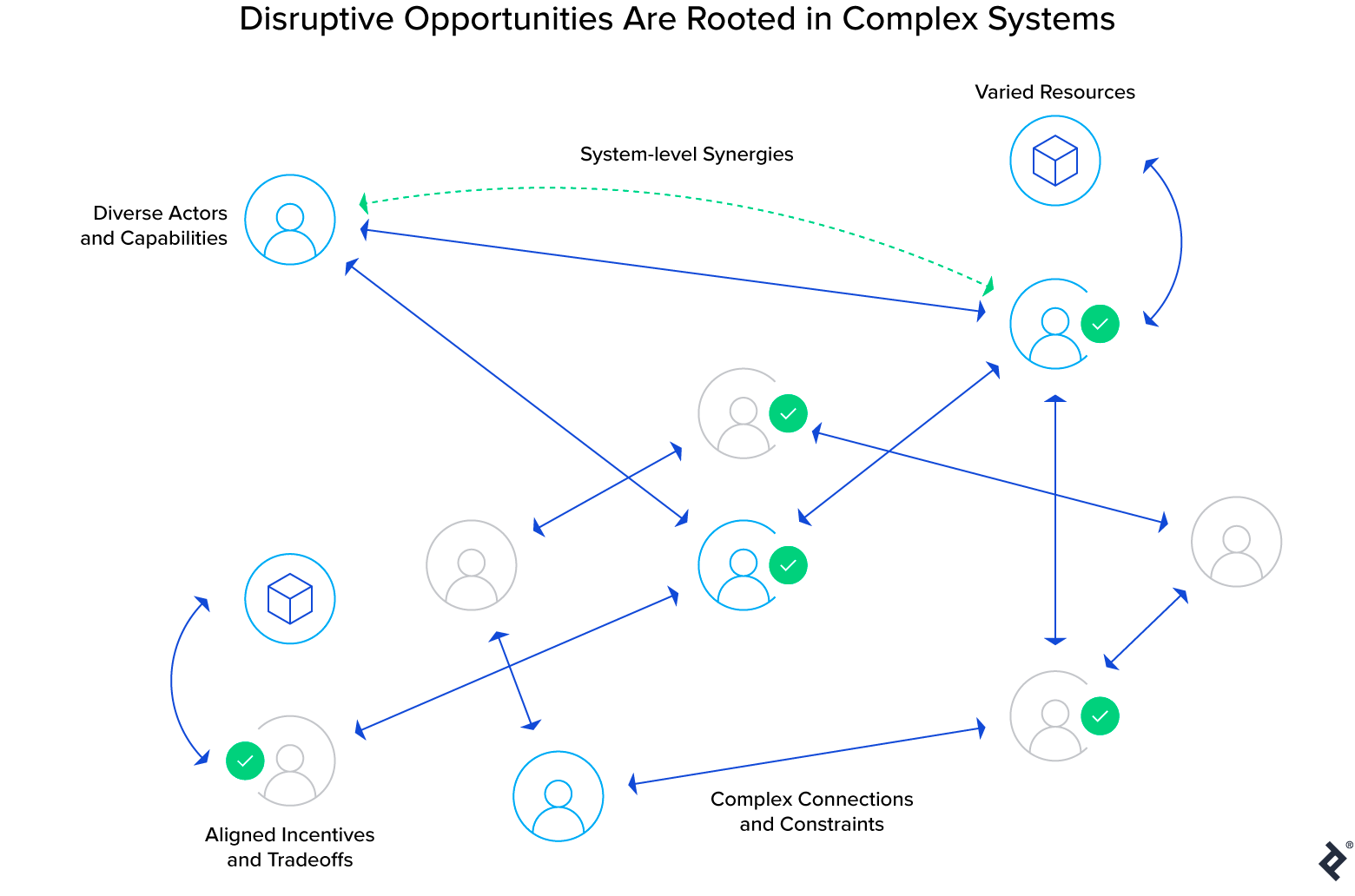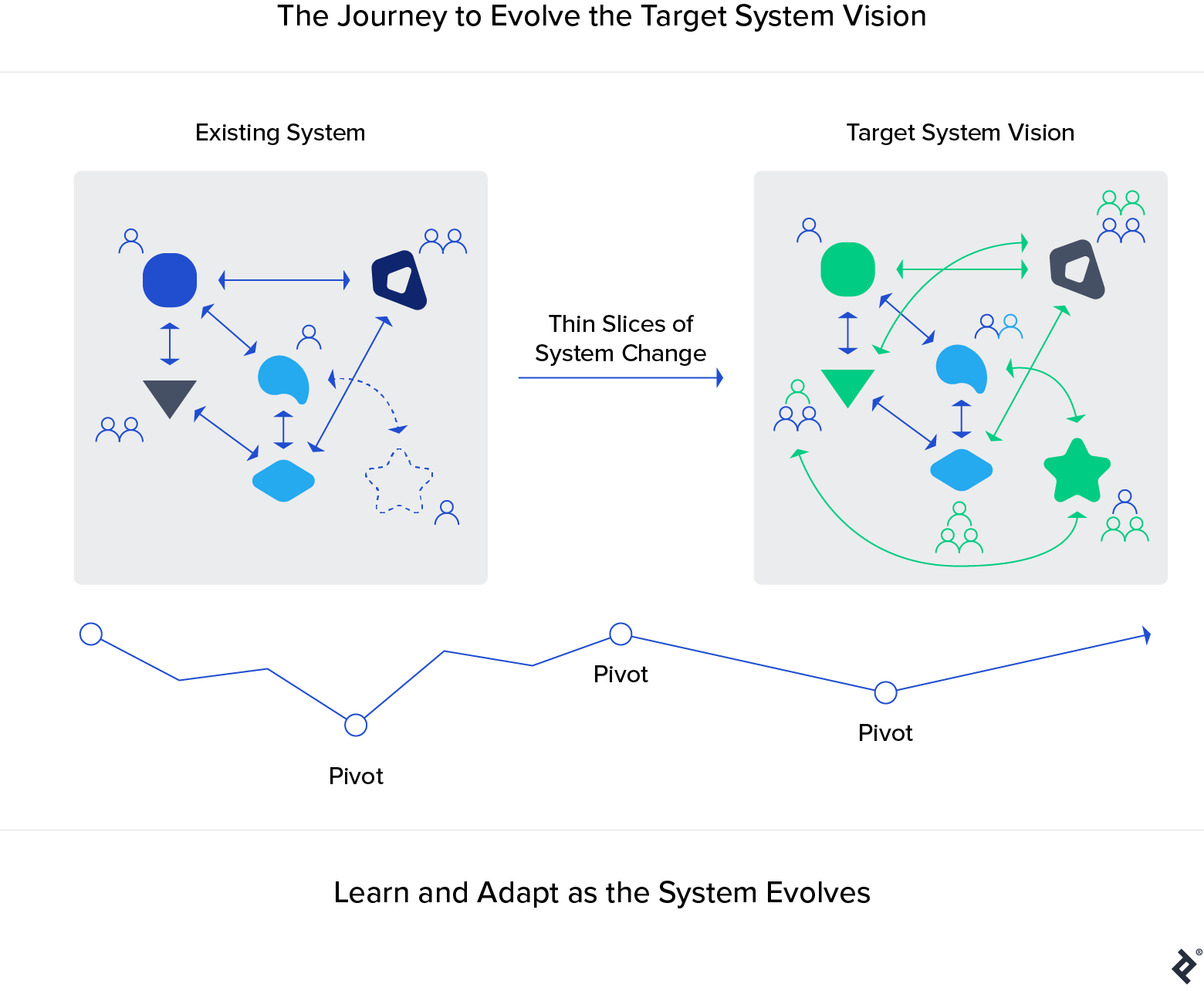Mastering Disruption: The Art of Agile Complexity
Incremental improvement is no longer enough to deal with the complex problems facing the world today. Companies that master Agile complexity will unleash a new wave of disruptive innovation.
Incremental improvement is no longer enough to deal with the complex problems facing the world today. Companies that master Agile complexity will unleash a new wave of disruptive innovation.
Dan has advised global commercial firms, public sector agencies, and international nonprofits to imagine and execute Agile systems-level innovation.
PREVIOUSLY AT

A global health crisis highlights the disruptive challenge when systems designed to meet one need face radically different demands. In this environment, it can be tempting for innovators to jump in and enthusiastically offer a host of new inventions, drawing on well-established practices of product and service innovation. Fast-moving teams, often leveraging cutting-edge technologies, engage users, fail fast, and learn quickly as they rush to address specific needs.
These targeted solutions are deliberately limited in scope, which constrains their impact. During the Ebola crisis, Dr. Hans Rosling complained, “We had software developers constantly coming up with new, pointless Ebola apps (apps were their hammers and they were desperate for Ebola to be a nail). But no one was tracking whether the action was working or not.” The hard truth is that complex systems problems can’t be solved with piecemeal inventions. They need to be addressed with far more ambitious systems solutions.
Of course, the need for systems-level innovation is not limited to the world stage. Organizations in every industry routinely face the challenge of radical change, existential threats that commodify their markets or make their role obsolete. Answering these disruptions to the status quo demands a new set of innovation capabilities. We need the ability to intentionally create bold original systems offering bigger solutions to harder problems.
The Lure of Incremental Improvement
Incremental improvements are (usually) a smart investment. These focused, well-defined improvements have a clear path for building on existing success. They make what already works a bit better or a bit bigger.
- Improving performance and updating technology
- Adding or refining features
- Extending into adjacent opportunities

Because each change builds on a foundation of proven success, these investments are easy to justify. In addition, because incremental change is grounded in the status quo, it is easy to define and execute. In a stable environment, few people will ever be fired for being good at this kind of steady improvement.
Three Threats of Disruption
Incremental improvement is an effective strategy—until it isn’t. The conditions that produced the status quo’s sustained success will eventually change, exposing the organization to three catastrophically disruptive threats.
Disruption may begin with the end of growth. The status quo’s once unlimited potential finally reaches a plateau where incremental improvements no longer deliver new levels of success.
The opportunity matures, and as new competitors rush in, even clinging to past success becomes difficult. The resulting commodification erodes prior advantages, respect, and profitability.

Even more devastating is the possibility that disruptive new entrants will create an entirely new offering that makes incumbents irrelevant and obsolete. In the words of Larry Downes and Paul Nunes in Big Bang Disruption, these game-changers “enter the market simultaneously better and cheaper, and more customized […] exhibiting winner take all results.”
When the foundations of the status quo are swept away, there is no opportunity to benefit from a series of small well-executed changes. Only a bold leap to a new value proposition can set the stage for continued future growth. This isn’t groundbreaking news. Everyone has heard stories of once venerable companies that have run aground with shocking suddenness.
Abandoning Ship Under Clear Skies
World Economic Forum Executive Chairman Klaus Schwab describes this moment in history as the Fourth Industrial Revolution, a time when change is “evolving at an exponential rather than a linear pace. Moreover, it is disrupting almost every industry in every country. And the breadth and depth of these changes herald the transformation of entire systems of production, management, and governance.”
There is ample evidence that this is not mere hyperbole, which begs an obvious question: Why aren’t more leaders forgoing the easy comfort of incremental innovation and embracing their own disruptive change? Why is it not common practice to intentionally challenge existing systems and lay the foundation for a new status quo?
The first reason is rooted in courage and foresight. Disruption often doesn’t announce itself in time to prepare a suitable response. The early signs of trouble are often invisible and proceed quickly once established. This creates the need to undertake bold, confident change even before the rest of the organization experiences a pressing need. It is like choosing to abandon ship while the skies are still clear.
Creative Dead Ends
Courage and foresight are not the only barriers to successfully reimagining an organization. There is an even deeper challenge to overcome, one that is rooted in innovation practices.
While every student of business management is thoroughly instructed in the practice of incremental improvement, these familiar, well-tested techniques are ill-suited to the challenge of disruptive innovation.
Even so, when organizations face existential threats, they often turn to their familiar toolkit, relying on incremental thinking and practices to drive transformative change. Unfortunately, tools designed for small, measured change lead to more ambitious efforts into three creative dead ends.
- Silver bullet thinking (small). Drawing on inspiration-driven brainstorming techniques, incremental innovators seek to discover a silver bullet idea that will save the day. Unfortunately, ideas that fit on a post-it note are seldom capable of creating an original value proposition with a transformative impact.
- Naïve problem solving (simplistic). The world is filled with obvious problems. While it is easy to point at a challenge and propose a simple solution, naïve answers to hard problems often overlook the reasons the problems remained unsolved.
- Second best solutions (subpar). There is unprecedented creative capacity across the world. Every good problem and exciting opportunity has a host of imaginative minds already thinking about it. It is not enough to solve a problem, the solution must be both unique and exceptional to stand out from the inevitable crowd of creative competitors.

It can be enormously frustrating for “courageous” change agents to see their ideas shot down by those who understand the scale of creative change needed to upend the status quo. Sadly, even though the heart and effort may be present, an incremental approach to innovation is simply not up to the challenge of self-disruption.
Big budgets are sometimes used to cover up these shortfalls. For example, technology re-platforming projects are often positioned as proof of an organization’s commitment to the future. Yet, even when these projects feature cutting-edge technology, they often rebuild applications that reinforce the status quo.
Creating with Complexity
The complex nature of disruptive opportunities is at the root of why incremental innovation often falls short. The status quo is not a small or simple thing. Replacing it requires an entire system capable of producing value in a new and original way. These ambitious strategies are not a new product or service, they require an interconnected collection of actors, actions, and resources.
Examine cutting-edge ideas that disrupted their sectors in the past, and it will be clear that they were complex systems with lots of moving parts, varied actors, and cleverly constructed incentives. Intentionally creating this kind of disruptive opportunity requires an organization to imagine, design, and implement a system that has:
- Complexity and scale. The system must be sufficiently sophisticated and complex to do something with a meaningful impact. It must offer a substantive solution to a significant problem.
- Completeness and consistency. Systems don’t work by the 80/20 rule. It’s not enough to do the most important 20%. Complex systems are viable only when the parts work together. Naïve, half-baked ideas are not sufficient.
- Unique excellence. In a competitive world, the new system must bring together unique resources, thinking, and capabilities that can’t be easily replicated by others. It must do something difficult with originality and excellence.

These same factors were almost certainly at the core of the status quo’s past success. The challenge for the disruptive innovator is to find a way to intentionally deliver this same level of complexity, completeness, and originality in a future system.
Taking the Journey into Complexity
Creating complex systems can be exhilarating. The world offers the systems innovator a huge toolkit of actors, resources, and tools that can be used to realize bold new ideas. Taking advantage of this creative bounty requires a different kind of creative journey.
Step 1: Distill Complexity/See Systems
Disruptive challenges and opportunities can be constructed from a varied mix of actors and actions, a rich complexity that offers a huge number of creative opportunities. As a first step into complexity, it can be enormously useful to visualize how the organization’s tangled ecosystem works, describe the mixed toolbox of technologies and resources, and systematically explore potential users, partners, and collaborators.
Seeing these broad patterns and systems makes it possible to talk and think about complex things. Surprisingly, many organizations have a limited ability to see or discuss this big picture view of their sector or even their own operation. A broad, holistic perspective demands thinking that stretches beyond the specialized focus of day-to-day work. In most organizations, individuals and departments have mastered a closeup view of their part of the elephant, but there are few (if any) pictures of the entire beast.
A fragmented view of the world is a poor starting place for original, big picture thinking. If the members of an organization want to collaborate in the creation of bold ideas, they need to bring together scattered insights and create a shared view of how the world works as a whole. Ideally, this big picture perspective is captured in visual models that distill the messy complexity behind a web of interconnected actors, resources, and functions.
Step 2: Imagine a Target System
Incremental innovators can focus on specific well-defined challenges. In contrast, disruptive opportunities build on original systems that break boundaries and work in fundamentally new ways. This isn’t a small change or an extension to a well-understood world. Disruptive product leaders are intentionally plunging into the unknown, replacing the foundation of the status quo with a reimagined collection of actors, roles, and tools.
The scale of the vision combined with the level of uncertainty produces a creative dilemma. It is not possible to simply string together a series of opportunistic changes hoping that they will result in an elegantly conceived system that will change the rules of the game. At the same time, a journey into complex system creation can’t be fully planned out in advance. There are simply too many unknowns, dependencies, and emergent properties that need to be discovered and addressed along the way.
The disruptive innovator answers this dilemma by creating a target vision of the future system. This big picture view of the way the world could work highlights the key actors, interactions, incentives, and resources that come together to create a viable system. While not every detail will be defined, this holistic view of the target system acts like a star in the distance, a guide for a long-evolving creative journey.
Step 3: Evolve the Future
Ultimately, the goal of disruptive innovation is to create a complete, original system that pioneers new ways to create value. The target vision describes a holistic view of the final solution, but that still leaves open the question of how this transformative new system is to be implemented in practice.

It’s too risky to try and break the project up into parts and then simply assemble the parts in the end, hoping that it will all magically work together. There are too many unknowns, uncertainties, and things to be discovered as work progresses. As a result, the tangle of interconnected actors and actions needs to evolve as part of a world that is itself both messy and changing.
Thin slices of the eventual system can be used to navigate this evolutionary journey. Each thin slice establishes a new capability where multiple elements of the system collaborate and interact with each other. The thin slice allows the innovator to see whether the varied elements will work together as planned. It also provides insights that make it possible to pivot around barriers and pursue unanticipated opportunities.
The creative journey is deliberately inclusive, potentially engaging the entire organization, its partners, as well as drawing in new collaborators. As each slice is implemented, it moves the effort a bit closer to the target vision, which may be adjusted and revised as the system evolves.
Build an Agile Enterprise
This agile dance with complexity can be at odds with organizations designed for top-down management and rigorous operating procedures. Highly regarded best practices such as rigorous project management or even independent innovation labs generally fail to provide the support needed for disruptive system innovation.
A more agile enterprise needs to be created to support the evolution of disruptive new systems. Because ambitious system change involves a broad range of participants, the entire organization will need to participate in a series of explorations and adaptations. It won’t be sufficient to relegate the work of change to a specially trained and empowered team, many more people and institutions will need to work together to shape the change.
Agility needs to be established as an enterprise capability, making it possible for every part of the organization to adapt and contribute to the creative journey. This requires new processes and incentives that are focused on creating and testing thin slices of system change. Thinking and institutions need to be far more adaptive and future-focused.
Obviously, this kind of organization shift itself is a transformative journey. However, the rewards for mastering agile complexity are substantial. Revolutions of change are sweeping every sector, and few organizations will be able to cling to the status quo. Getting good at disruption offers a bold and exciting way forward.
Further Reading on the Toptal Blog:
Understanding the basics
What does incremental delivery mean in Agile?
Incremental delivery in Agile means that product updates are released in small but regular batches—usually every 2-4 weeks—instead of one big release at the end of the development cycle.
What is ideal time in Agile?
Ideal time in Agile refers to an estimation method where task completion time is estimated in ideal hours or days. It simply means the time a task takes to implement in the absence of any interruptions. An eight-hour workday would typically have 5-7 ideal hours.
What is the difference between iterative and incremental?
Iterative development refers to time—i.e., a product being updated on a constant basis. Incremental means that a product is updated in small batches but not necessarily over a constant timeframe.
What is an incremental process?
An incremental process refers to a product development framework where updates are developed and released in small batches in small timeframes instead of big and chunky releases over longer periods of time.
What is Agile innovation?
Agile innovation can refer to many things, but most typically, it would mean innovation that is done in an iterative and incremental process.
Dan McClure
Bloomfield Hills, MI, United States
Member since December 11, 2019
About the author
Dan has advised global commercial firms, public sector agencies, and international nonprofits to imagine and execute Agile systems-level innovation.
PREVIOUSLY AT


